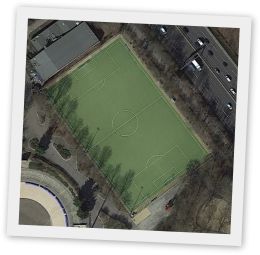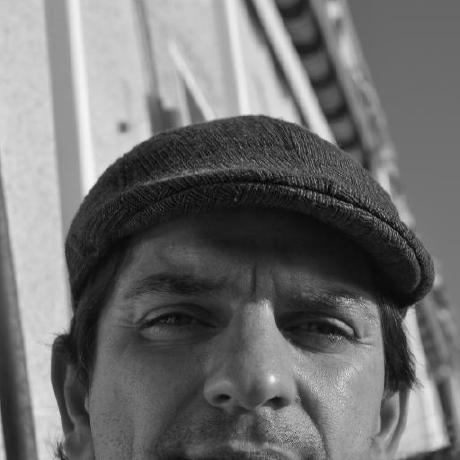The FIFA World Cup in 2006 had an impact on the development of Berlin's soccer fields
Here in Berlin, there are 450 soccer fields (some call it football or fútbol) across the city. How do I know? Well, OpenStreetMap has them all. I downloaded their spatial data1, added temporal information from recorded satellite images, recognised the pitch surfaces and analyzed their recent changes.

The motivation for the blog post is associated with the answer to the rather insignificant question. “Was there any change in Berlin’s soccer infrastructure when the 2006 FIFA World Cup was hosted in Germany and the final was scheduled in Berlin?”
Soccer Field Types
Generally speaking, soccer pitches can be distinguished according to their characteristics and appearance. In this blog post, I focused on three different surface types:
Surface: Natural Grass

Hybrid grass is natural grass reinforced by artificial fibres. With this system one tries to combine the optimal playing characteristics of natural grass with the robustness and resilience of synthetic grass.
Surface: Artificial Turf
Artificial turf is a kind of plastic carpet that is similar in texture and appearance to natural grass. Most artificial turf is produced using the so-called tufting process. The yarns used are made of polypropylene, polyethylene or polyamide. The fibres are coated with latex and usually additionally stabilized.

Over the last few decades, a great deal has happened in the development and production of artificial turf systems. Currently we are already in the 4th generation, and the end of development is far from being foreseeable. A short history of artificial turf is provided by fixgreen.
- 1st generation - (hard soils, very high risk of injury) For the first time in the 1960s, this is a dense, unfilled synthetic yarn turf. As a result, the artificial turf of the first generation was known for its high risk of injury due to its hard ground.
- 2nd generation - (first sand filling, also suitable for sliding tackle) In this generation the artificial turf is sand-filled for the first time. This ensures a better sliding quality than in 1st generation pitches. However, damping in this generation is still very poor.
- 3rd generation - (rubber filling, with good damping properties for the first time) The third generation works with synthetic grass fibres and sand and rubber granulate filling, this generation is certified for the first time by UEFA and FIFA. The elastic cushioning makes the floor very resilient and gives a good playing feeling.
- 4th generation - (playing characteristics close to natural grass) The latest generation of artificial turf systems, processed with synthetic grass fibres of different sizes and thicknesses, thus replicating natural grass. The risk of injury is even lower for this generation than in the previous version.
The advantages of artificial turf compared to the natural grass pitch are obvious: all-year-round, weather-independent playability, the playing characteristics are homogeneous over the entire field and of course the low-cost maintenance.
Surface: Hard Pitch

Soccer Field Development In Berlin
In Berlin, we have the situation that there are more soccer fields now than ever. In the last 17 years were 18 new soccer fields built. In most cases, unused areas were converted for this process. However, 11 out of the 18 new fields have been created in the years before the World Cup 2006 in Germany. Until 2006 have 28 soccer fields been converted from hard pitch into a artificial turf pitch, while 14 soccer fields were converted from natural grass pitch into artificial turf pitch.
The analysis revealed another interesting fact. Since 2002, exist more artificial turf pitches throughout the city than any other surface type. Meaning, artificial turf distributor companies are the clear winners and beneficiaries of this market trend.Since 2002, the majority of soccer fields in Berlin are artificial turf pitches.
Current Situation In Berlin (2016)
Due to the different population numbers, the density of buildings and the long division of the city, the situation of football pitch availability among Berlin districts2 looks very different today.
- Most soccer fields are in the district of Charlottenburg-Wilmersdorf (64).
- Friedrichshain-Kreuzberg, Marzahn-Hellersdorf, Mitte and Tempelhof-Schöneberg have no hard pitches anymore.
- Treptow-Köpenick is the only district with more natural grass (26) than with artificial turf (17) pitches.
- In Friedrichshain-Kreuzberg, 90 % of the soccer fields have artificial turf while only 10 % remain with natural grass.
Installation Of Artificial Turf Pitches
While validating the classification results I came across pictures in Google Earth which were taken at the moment of artificial turf installation, in the following section a small selection is shown.
Sportverein Stern-Britz 1889 e.V. - Neukölln - 2014
#### Volkspark Mariendorf - Tempelhof-Schöneberg - 2014 #### SG Rotation Prenzlauer Berg e.V. - Pankow - 2016 #### Sportanlage Westend - Charlottenburg-Wilmersdorf - 2006Bottom line
You can cite this blogpost using: Gärtner, Philipp (2017/12/15) “The FIFA World Cup in 2006 had an impact on the development of Berlin’s soccer fields”, https://philippgaertner.github.io/2017/12/berlin-soccer-fields/
If you have any questions, suggestions or spotted a mistake, please use the comment function at the bottom of this page.
Previous blog posts are available within the blog archive. Feel free to connect or follow me on Twitter - @Mixed_Pixels.
Data Source
- Soccer pitch polygons: The spatial data for the soccer pitches come from the BerlinOpenData - OpenStreetMap data for Berlin page (last update: 12.12.2016; license: Open Data Commons Open Database License - ODbL). [return]
- Berliner Bezirke [return]


